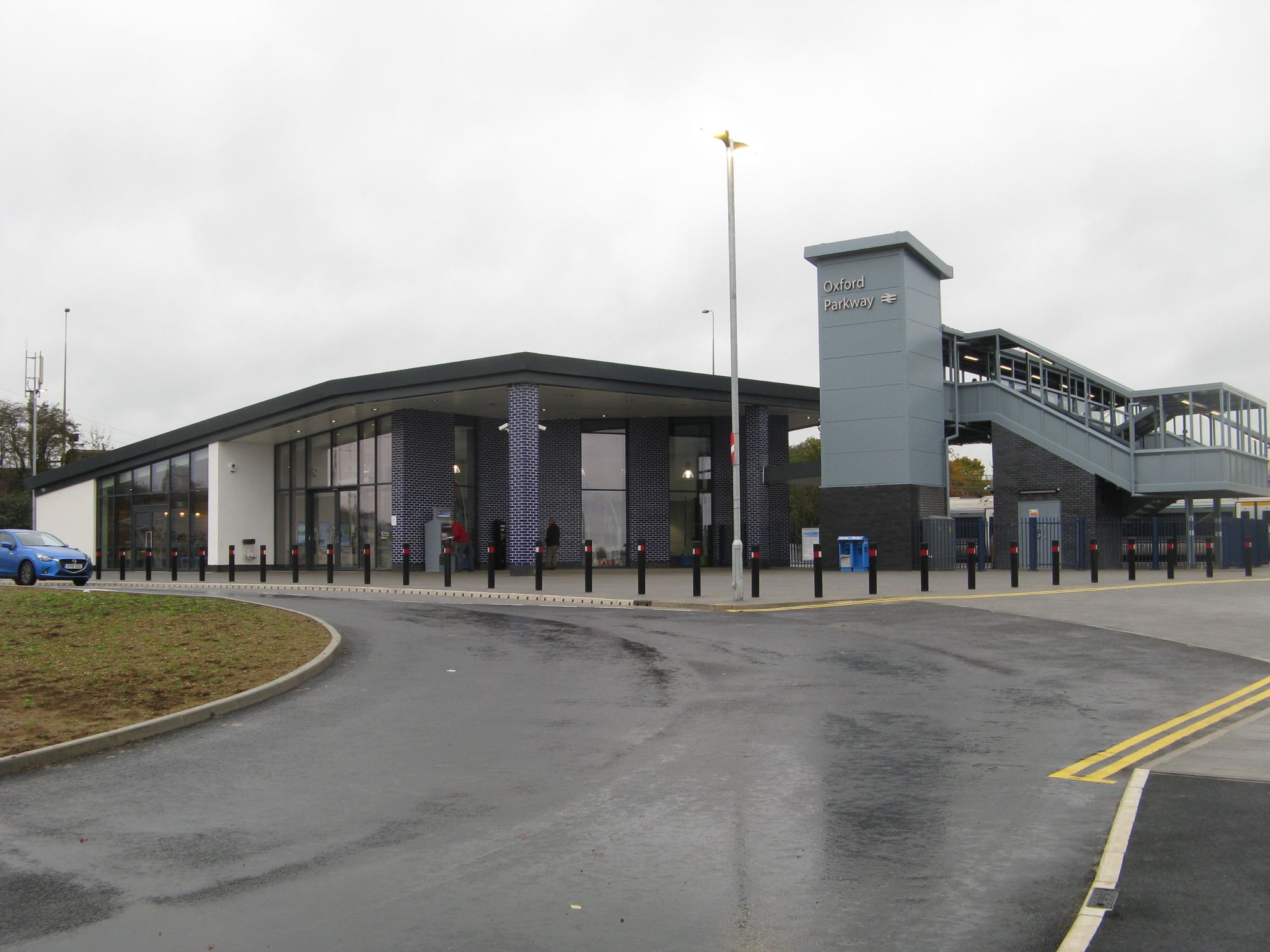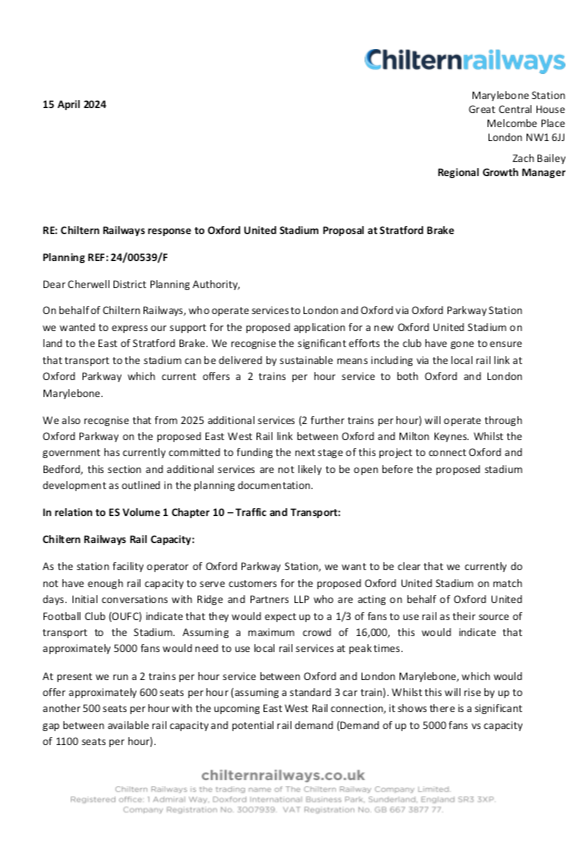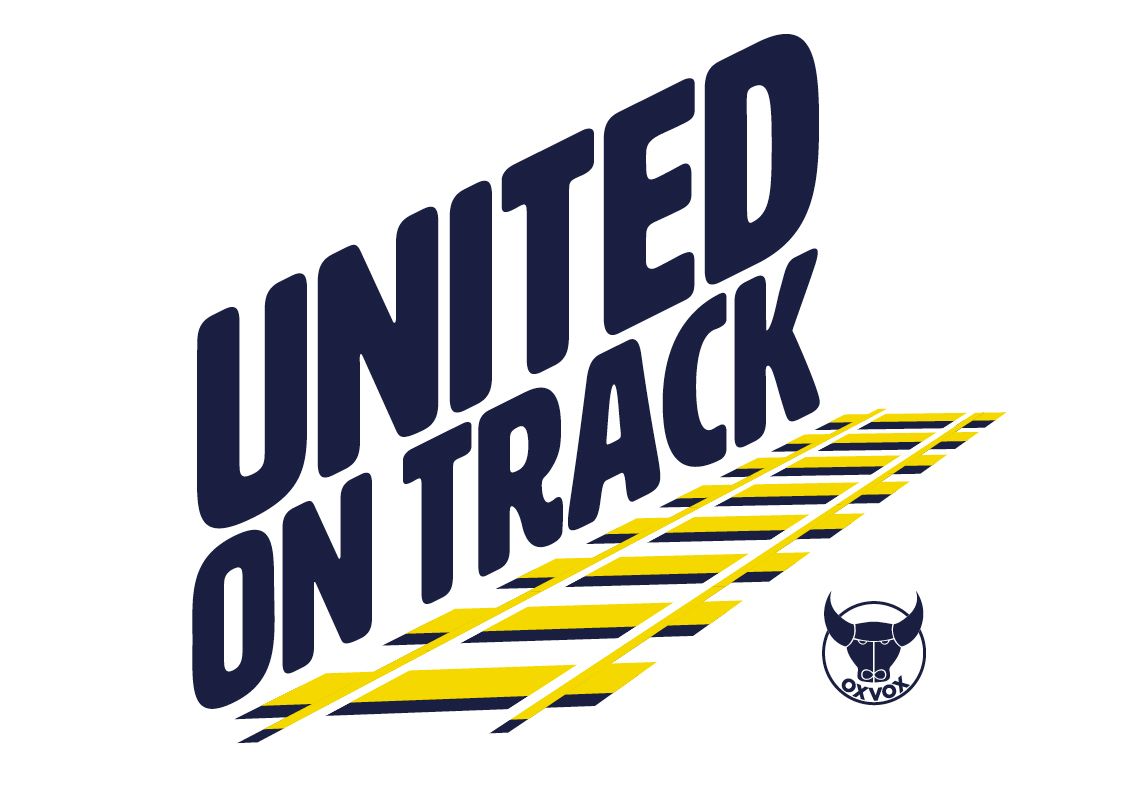We’re all going to Wembley… by train

Water Eaton has never known anything like it. Oxford United’s play-off final is this Saturday, and the tiny hamlet will have up to three trains an hour to Wembley Stadium.
Water Eaton is of course also Oxford Parkway, the city’s second railway station. Like so much about the revived Chiltern line, this was the brainchild of Oxfordshire’s great railwayman, the late Adrian Shooter. The new station opened in 2016, and for a while hopes were high that it would provide a fast, comfortable, cheap alternative to GWR’s Paddington line.
It didn’t quite work out like that. GWR’s new trains gave Paddington a speed boost, Chiltern Railways fell under the penny-pinching control of bus company Arriva, and for better or worse, the swashbuckling early days of rail privatisation were replaced with Government micro-management. Post-Covid, the Department for Transport was less keen on train companies competing with each other, and Chiltern was encouraged to stick to its core business of transporting commuters from the Chilterns, Banbury, Bicester and Warwickshire. Had the Bicester/Oxford Parkway link not been built 10 years ago, it might not be built now.
But many people have cause to be thankful it was. Bicester Village shopkeepers; the worldwide tourists who visit them; Kidlington and Cutteslowe residents; north Oxfordshire railheaders who park up daily for their London commute.
And most of all, Oxford United fans.
Train-ing ground

It’s no exaggeration to say that Oxford United’s hopes for a new stadium at the Kidlington Triangle rest on Oxford Parkway.
In stadium terms, the Triangle site is tiny. Birmingham City have purchased a 60-acre site, 1.5 miles’ walk from New Street station, for their new stadium. The Triangle is just 12 acres, and 4 miles from Oxford’s central station. There simply isn’t the space for Kassam-like expanses of car parking. Traffic is already the chief concern of those objecting to the stadium plans: had the minimum-parking stadium design been proposed without Oxford Parkway over the road, the objections would be deafening.
Can Oxford Parkway fulfil the hopes resting on it? Chiltern Railways are clear that it can. But right now, that’s a “can” – and not yet a “will”.
Chiltern’s response to the OUFC planning application is striking. Though planning authorities tend to draw a less binary distinction between ‘support’ and ‘object’ these days, consultees’ comments are more often phrased as “no, unless” rather than “yes, but”. Chiltern’s is best described as a “hell yes, although”:
On behalf of Chiltern Railways, who operate services to London and Oxford via Oxford Parkway Station we wanted to express our support for the proposed application for a new Oxford United Stadium on land to the East of Stratford Brake. We recognise the significant efforts the club have gone to ensure that transport to the stadium can be delivered by sustainable means including via the local rail link at Oxford Parkway which current offers a 2 trains per hour service to both Oxford and London Marylebone.
The modern railway industry is famously risk-averse. Enthusiastic language like this is unusual. Chiltern sees the “potential positive impact this will have for rail revenue”, and wants to seize it.
Still, there is an “although”. Its crux is that “Whilst Oxford Parkway is a relatively new station, it is not designed to accommodate up to 5000 customers over a short period of time.”
Oxford Parkway’s pedestrian and cycle accessibility has been recognised as sub-par from day one. Campaign groups lobbied for it to be improved, to no avail. Access is via a narrow roadside shared-use path, and London-bound pedestrians from Kidlington are required to double back over the bridge. It copes with current numbers, but these are just 1600 passengers per day. 5000 passengers at once is, if you’ll excuse the metaphor, a whole different ball game.
Chiltern sets out a series of design changes that it thinks could ameliorate this.
- “The implementation of infrastructure to enable a match day queuing system at the front of the entrance of Oxford Parkway Station.” This is likely to be fairly simple and cheap – some reconfiguration/enlargement of the paved space.
- “Improved walking infrastructure to ensure thousands of fans can walk down from the A4165 to the station entrance in safe and accessible manner. For example, a widened footpath from the A4165 down the embankment.” Anything that requires earthworks isn’t cheap, but this shouldn’t be prohibitively expensive. (It does highlight, though, that the existing roadside path will need widening.)
- “Funding for additional customer facilities at Oxford Parkway for match day usage.” Toilets, seats, shelters. Again, not expensive.
- “A review of options to understand how fans could safely access the London bound platform at Oxford Parkway. Currently fans must go via the main entrance and over a bridge. This is unlikely to be a feasible model for future match days as the station ticket hall will become significantly congested. Suggestions could include building a direct footbridge between the A4165 and the London bound platform at Oxford Parkway.” Here’s where the chequebook comes out. A new accessible walkway with ticket barriers, linking the high embankment to platform level, could potentially involve a seven-figure bill.
There are also hints about “additional rolling stock” being needed. Though the letter is addressed to Cherwell District Council, our reading is that this is a negotiating position with the Department for Transport, not OUFC or Cherwell. Chiltern has a tender out at present for new trains to refresh what’s, on average, the oldest fleet on the network (thanks, Arriva). Citing high demand from OUFC supporters makes Chiltern’s case for the tender to include more carriages.

Making the case

This Saturday is, of course, the play-off final at Wembley between Oxford United and Bolton Wanderers – OUFC’s chance for promotion to the Championship.
Supporters’ group OxVox sees this as an opportunity to demonstrate that fans can, and will, take the train at Oxford Parkway. It has launched a campaign, ‘United On Track’, to “show those making the decisions that our fanbase is not only happy to use the train, it’s absolutely the preferred option”. Through an online survey, it’s asking Wembley-bound fans to say where they’re travelling from, and whether they’ll be using the train.
Chiltern Railways, meanwhile, is pulling out all the stops. (Not literally. The trains will still call at Bicester Village.) It’s running extra trains but, unusually, these will start from Parkway and not Oxford central. The bay platforms at the main station aren’t long enough for the nine-carriage trains Chiltern plans to run, while turning services in the through platforms would cause congestion.
That’s a consideration that has been occupying the minds of those planning Parkway’s other rail service, East-West Rail. The new line to Milton Keynes is expected to open in late 2025. MK Dons might not be appearing on OUFC’s fixture list any time soon, but the link to the West Coast main line opens up easy connections for away teams from the North West. As the East-West service ramps up, finding somewhere to turn trains becomes a priority. One suggestion is the reopened Cowley branch line – leading to the entertaining possibility of a direct train from the (former) Kassam Stadium to the Triangle.
Saturday isn’t quite a dry run for the new stadium. Departure times from Oxford Parkway will be staggered. There’s little chance of crush conditions.
But if it works well, the transport arguments for the Triangle stadium will be greatly strengthened. Oxford United supporters should offer up a little prayer for the late Adrian Shooter, whose brainchild could be the clincher for their new stadium.

